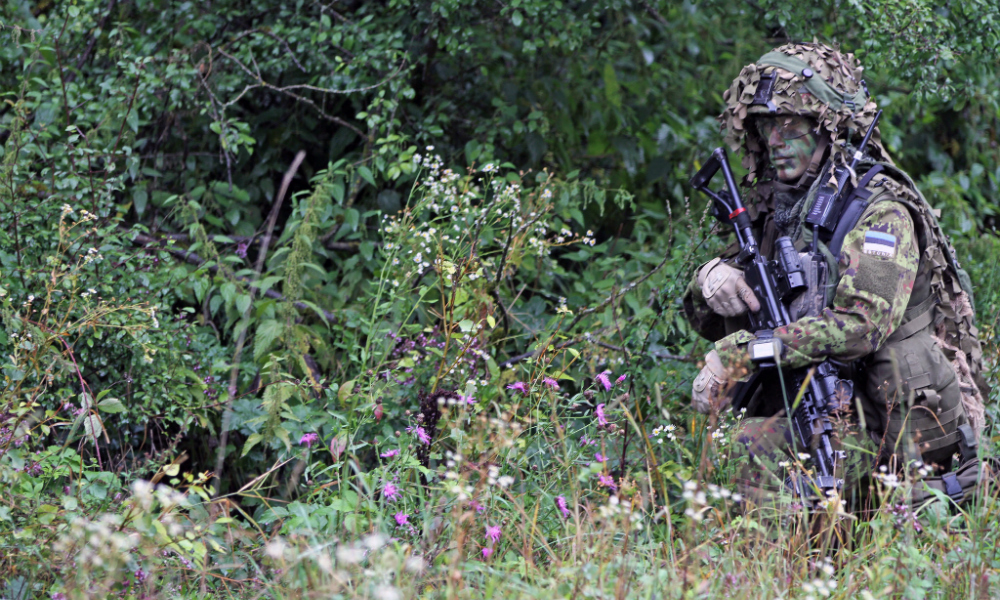Editor’s note: The following is based on the authors’ recent article for the Royal United Services Institute journal, “Confronting the Anti-Access/Area Denial and Precision Strike Challenge in the Baltic Region.”
Early next year NATO will deploy four battalion-sized task forces in Poland and the three Baltic countries of Estonia, Latvia, and Lithuania. This deployment is intended to reassure those countries threatened by Russia’s growing assertiveness, particularly in the wake of its annexation of Crimea. Although NATO’s actions are an important step in the right direction, questions remain. Can four battalion-sized units meaningfully enhance the region’s ability to defend against an invasion? If a relatively small number of NATO troops cannot repel an invasion, can they still deter aggression by serving as a “trip wire”? And do limited troop deployments fully address our allies’ security concerns given their proximity to Russia?
Unfortunately, we have strong reasons to worry about the answer to all three questions. Individually and collectively, the Baltic states face a massive conventional military imbalance vis-à-vis Russia. The positioning of nuclear-capable missiles in the Kaliningrad exclave could leave them susceptible to nuclear blackmail.
As if these stark realities were not formidable enough, an even more insidious obstacle deserves attention: NATO forces will be highly vulnerable to Russian anti-access/area denial (A2/AD) and precision-strike weapons. Such capabilities make it even less likely that four battalion-sized task forces will enhance defense, deterrence, or reassurance.
To understand why, think about how Russia would likely use its A2/AD and precision-strike weapons were it to invade the Baltic countries. Whether it opted for a conventional attack or a hybrid incursion, Russian forces would probably use precision-strike weapons to preemptively isolate the area of operations, to disrupt defenses, and to destroy pre-positioned heavy military hardware. Large-scale snap military exercises suggest that Russia has the ability to mobilize and transport 72,000 troops in a matter of days. Russia could thus seal off the region relatively quickly if it decides to engage in territorial conquest.
In such a scenario, maintaining—let alone regaining—access to the region would be difficult and costly. Russian forces could use anti-access weapons to impose heavy losses on follow-on forces. Its local naval forces—particularly the Baltic Fleet—could conceivably blockade the region and complicate attempts to reinforce and resupply besieged NATO forces. Nor can NATO take air superiority for granted. Only a handful of NATO airplanes participate in the Baltic Policing Mission at a given time. Long-range anti-aircraft artillery missiles located in Kaliningrad and St. Petersburg—to say nothing of Russia’s own air force—could hamper efforts to ensure an aerial presence over the Baltic region.
In sum, a very real risk exists that Russia could present NATO with a fait accompli. The result would be devastating for NATO and the United States. Aside from losing NATO member states to external aggression, Article 5—the gold standard against which alliance promises are judged—would be in tatters and NATO credibility would suffer accordingly. The United States and its NATO allies may even discover that they have become the ones being deterred, partly because the precision-strike and A2/AD challenge is too severe to try to overcome, but also because Russia’s leadership could threaten to use nuclear force in response to any effort to reverse the new status quo.
So what alternatives are available to the United States and NATO? One obvious option is to deploy additional NATO task forces. However, sending more NATO troops to the region is neither politically feasible nor geopolitically desirable. Additional troops are likely to antagonize Russia, and NATO is rightfully wary of making war a self-fulfilling prophecy. Another approach is to use NATO forces and weapons to hold Kaliningrad sufficiently at risk. This latter option is appealing but it could still be inflammatory, since Russia could perceive a threat that NATO might use these weapons preemptively.
We suggest a third option. Make insurgency a core mission for Baltic ground forces. Instead of training and equipping Estonian, Lithuanian, and Latvian soldiers to fight like NATO units, prepare them to fight asymmetrically from the outset. In other words, enhance deterrence by making it harder for Russia to consolidate control over NATO territory.
Our proposal has four advantages. First, insurgency works. Conventional military operations—of the type that the Russian army has invested heavily in as part of its modernization efforts—are often counterproductive when used against insurgents. Conventional forces have experienced difficulties adapting to the demands of counterinsurgency warfare. Second, many analysts suggest that despite the Russian military’s focus on modernization and readiness, it remains inadequately prepared for prolonged operations. Because Russian forces are already tied down in Ukraine and Syria, the prospects of having to wage a long campaign in the Baltics—especially if they must also fight NATO’s conventional forces—could enhance deterrence in the short run. Third, when launched in response to clear-cut external aggression, insurgency has the virtue of being unambiguously defensive. Unlike conventional weapons and doctrines, the tools of insurgent warfare are not useful for seizing territory or striking targets. Finally, given sheer military imbalance, it makes little sense to use Baltic ground troops in a conventional role. Doing so violates strategic common sense by pitting weakness against strength. Insurgency does the opposite. Estonian, Lithuanian, and Latvian soldiers understand the terrain. They know the people, the language, and the culture. And they will be highly motivated to make invaders pay dearly.
Some readers might object and argue that if Russia invades and occupies the Baltics, a NATO response centered on supporting an insurgency would irrevocably undermine the alliance and US global commitments. This critique has two weaknesses.
First, it implies that the alternatives are better for NATO’s credibility. But the current approach is unlikely to deter Russia or stop an invasion, and deploying more troops runs a high risk of triggering the very war that NATO wants to prevent. Insurgency offers a middle path. It is less provocative and more likely to prove effective. Second, this critique implies that the options available to NATO are mutually exclusive. However, simply because our allies in the Baltics prepare to wage an insurgency does not prevent NATO from preparing for conventional defensive operations. Even Mao Zedong observed that insurgents are most likely to succeed when they coordinate their efforts with conventional forces. Similarly, NATO can still boost measures towards Kaliningrad and the Suwałki Gap while the Baltic countries prepare for insurgency. The alliance should adjust its nuclear posture in order to regain control of the escalatory ladder. Far from being mutually exclusive, NATO must bolster deterrence at various levels of violence simultaneously, whether sub-conventional or nuclear.
NATO faces serious challenges in the Baltics. However, the situation is not hopeless. War is not inevitable. Because insurgency presents Moscow with the greatest difficulties in the event of its potential aggression in the region—and undercuts the advantages Russia gains from its A2/AD and precision-strike capabilities—it offers the best strategic option for avoiding conflict in the first place.
The views expressed here are the authors’ own and do not reflect those of the Department of Defense, US Army, or US Military Academy at West Point.
Image credit: Sgt. Christina M. Dion, US Army




The idea of insurgency as a deterrent to Russian aggression is intriguing, but I see one fatal flaw. A successful insurgency requires a significant degree of popular support, allowing the insurgent force to camouflage itself in the social terrain. In the Baltic states, however, this could be problematic due to the large population of ethnic Russians, many of whom appear to be loyal to the Motherland. This, in effect, provides the Russians a prepositioned network of informants who could identify individuals who are either members of the armed forces or who have received training in insurgent tactics and methods, effectively crippling a nascent insurgency. While this would not necessarily eliminate the insurgency altogether, it would buy the invaders precious time while the insurgency rebuilds its strength, possibly enough time where NATO would still have to acknowledge a fait accompli.
Using insurgency as a means of challenging Russia's recent actions is an interesting concept. The effect of using insurgency would theoretically have the same effect that the constant counterinsurgency efforts have created for the US in the Middle East. That kind of resource expenditure can easily split Russia's resources and delay their efforts to show power in the Baltic region of Europe. The problem is who will be using these means of war. If the UN uses insurgency as a method of warfare, it could cripple the nations' credibility. Any nation will likely experience civil unrest by partaking in this strategy. Insurgency has created a large rift in the free world today because of the terror it has created in nations across the world. This is the risk the UN is taking if they use these methods. If this is used as a strategy, the UN must keep in mind the consequences it will face from the public.
Even with insurgency being the best strategic option, I still don't see a high probability that it will be successful. Russia has the majority of the advantages in this situation and if they want to try anything, it is likely that they will be successful against NATO members.
I agree that Russia has an obvious advantage both politically and geographically, which makes any proposed strategy a gamble. I believe that out of all the options available to the US and NATO right now, insurgency is the best bet, but will have to be treaded on carefully as the many loyalties in the geographic region pose a severe threat to this strategy.
Using insurgents as a way of countering Russian aggression is an interesting concept, but I doubt it will be successful for a number of factors. As others have pointed out, the Baltic states were fairly recently part of the Soviet Union, and there are undoubtedly those who remember that time and are still loyal to Russia. Furthermore, the United States struggled to know the land in comparison to locals in Vietnam, Iraq, and Afghanistan because of the geographical distance and unfamiliarity of an alien land. I would imagine that US forces would have been more comfortable fighting in Canada, which is a geographical equivalent of Russian forces in the Baltics. Even if using an insurgency is politically acceptable, it will most likely not be effective enough to be a significant factor in a potential Russia invasion.
They key difference with these NATO members is that they will be the ones waging an insurgency in their own country. How did the insurgency go for the Viet Cong in Vietnam, AQ (among others) in Iraq and the Taliban in Afghanistan?
We must also remember that the strategic purpose of US and NATO forces in Eastern Europe is not to defeat Russia, but rather to deter them from initiating a conflict and to reassure our allies and treaty partners that we will back them up in the event that Russia does.
Insurgency is the most realistic tool that we can use for physical protection and combatting Russians in an area where they hold the advantage. Precisely because it is the most cost-effective and attritive thing that we can do to oppose Russia in the Baltics, it is a great option to both deter and reassure, which are our strategic priorities in the region.
Of all the options listed, I feel as though insurgency would be the best option. However, one thing to consider is that in this day and age, countries must be thinking about mutually assured destruction (MAD) before they make any strategic moves. Though four battalion-sized NATO task forces may not pose any threat to Russia or be successful at deterring, it is almost guaranteed that other countries would jump into war in support of their allies. Knowing this, Russia should be careful when it comes to the Baltic region.
This is a very practical approach. In the event that the US or some other part of NATO refuses to uphold Article 5 of the North Atlantic Treaty, these peoples need to be able to defend themselves against a Russian occupation and invasion. These nations militaries can potentially be more useful as a competent core of a popular insurgency, working in tandem with other NATO conventional forces, than solely as a conventional force. The Russians have experience with COIN, but insurgencies in multiple countries at the same time will tax their forces and wreck havoc on their supply lines.
The decision to support and train an insurgency rather than an easily decimated conventional force seems like it would be the more favorable option in terms of resources and numbers. However; this route may lead to the discrediting of the NATO promise to defend and support the former satellite states. The states would gladly fight from inside an occupied homeland and wage insurgencies, but the fact is that no Eastern European state wants to be invaded in the first place. Putting NATO efforts into an insurgency force will immediately make our allies in need feel as though we have written off their sovereignty.